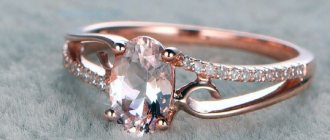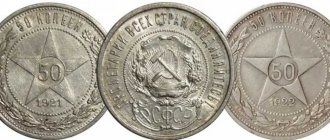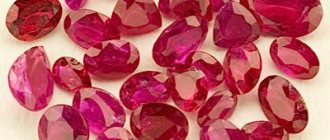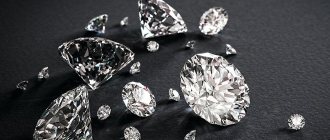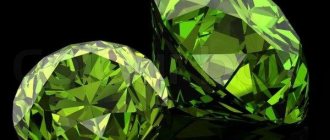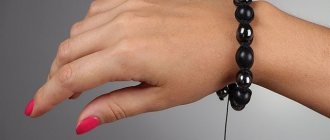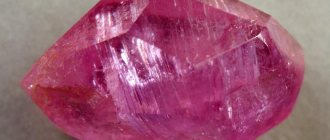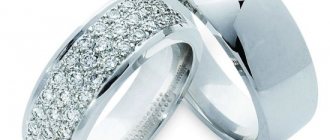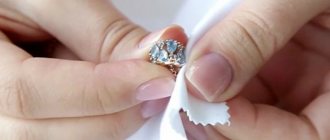Historical reference
The history of cognac diamonds is no less amazing than the beauty of gems.
The first specimens of brown diamonds were discovered in the 50s of the twentieth century in Australia. Initially, precious gems were recognized as technical, they were used in industry, scientific and technical research.
Almost five decades later, in 2001, Belgian jeweler Pascal Bruni presented to Swiss society a collection of jewelry dominated by brown diamonds, at that time already called “cognac”. The intrigue was heightened by the news that the Australian mines from which these stones were extracted are practically depleted. Visitors to the exhibition in Basel appreciated the jewelry and immediately sold it out.
Since then, cognac diamonds have been in great demand in prestigious houses.
A variety of brown diamonds
Brown diamonds are divided into varieties according to their color range. We have already mentioned the most popular shades of such minerals above.
Such stones are also divided according to their carat weight. There are large, medium and small brown minerals.
The shapes of stones are also quite diverse.
The general classification of diamonds divides them into white and colored. Brown diamonds are among the colored varieties, but they are the cheapest types.
How does brown color come about?
In nature, the color of a brown diamond is formed in the same natural way as other shades of this mineral.
Under the influence of high temperatures and pressures arising in the depths of the earth's crust, the crystal lattice of diamond is deformed. As a result, atoms of crystalline nitrogen, iron and nickel are added to the carbon in the mineral. The amount of these elements in the composition determines the saturation of the diamond’s shade.
If nitrogen does not change its form from gaseous to crystalline during the process of addition, then the diamond remains colorless.
Physical and chemical properties
Cognac diamonds are naturally brown diamonds. A colorless diamond is made of pure carbon. Brown specimens are formed due to the fact that, under constant and prolonged exposure to pressure and high temperature, slight deformation of the crystal lattice occurs. During the transformation, atoms of iron, nitrogen and nickel are built into it. Their percentage ratio determines the shade and saturation of the brown color.
| Formula | C |
| Color | All shades of brown, brown-yellow, brown-orange, coffee, chocolate and others |
| Probable impurities | Iron, nickel, nitrogen |
| Shine | Diamond |
| Hardness | 10 |
| Transparency | Transparent |
| Strength | Lasting |
| Kink | Conchoidal to splintery |
| Cleavage | Perfect by (111) |
| Density | 3.47-3.55 g/cm3 |
| singonia | Cubic |
| Refractive index | 2,417-2,419 |
Classification
Cognac diamonds are classified according to two criteria - quality characteristics and shade. In the first case, minerals are divided into two categories:
- Elite (fancy) - stones of rich colors, the structure of which does not contain nitrogen crystals.
- Cape – yellow-brown crystals (Cognac Diamond). Nitrogen crystals contained in this type of diamond reduce their transparency and density, which negatively affects the quality of the specimens.
Depending on the shade, there are seven main varieties of cognac diamond:
- Champagne - crystals of the lightest, almost yellow, shades.
- Cognac – yellow-brown specimens.
- Brown is the most common color of a cognac diamond.
- Chocolate is a rich dark brown color rarely found in nature.
- Honey.
- Walnut.
- Coffee.
Jewelry value
Unlike white diamonds, for colored diamonds the main characteristic that determines the value of the stone is color. It outweighs even mass or purity.
Taking these features into account, a separate rating scale has been developed for colored pebbles, including cognac ones, with the following parameters:
- Hue. Main visible color; brown is welcome.
- Tone. Indicates the gradation of darkness of a hue.
- Saturation. The degree of color intensity. The higher, the more expensive the stone.
Gold ring with cognac diamond
The cost of the stone will skyrocket if the main color – brown – is complemented by orange shades.
Mineral deposits
Just a few hundred years ago, the depths of Brazil, as well as Central and Southern Africa, were full of diamond reserves. Today they are devastated and specimens worthy of attention are almost impossible to find.
The only deposit of cognac diamonds currently is the Argyle mine, located in Australia. However, even in this area, supplies are running out. There are no new developments in the search for cognac-colored diamonds expected in the near future, which means that the cost of currently existing specimens will skyrocket.
The magical properties of cognac diamonds
The magic of a cognac diamond lies in its energy. The stone gives its owner courage and iron willpower, which allows him to resist aggression and anger coming from ill-wishers. Brown gem helps to find a common language with others, smooth out conflicts and make wise decisions.
Diamonds in dark brown shades are more suitable for men. They develop leadership qualities and organizational abilities, promote career growth, and make their owner more purposeful, resilient and resistant to stressful situations.
Women should pay attention to the light shades of cognac diamond. Champagne-colored and honey-colored stones will relieve unreasonable worries and fears and have a positive impact on motherhood.
For everyone, a cognac diamond is a talisman of good luck. It will help you get rid of bad habits and find solutions to complex problems.
Talismans and amulets
Selenite box 7.5 cm
Selenite is magically powerful. It can serve as a talisman, a talisman, and an energy accumulator.
Hindus have always considered selenite stone sacred. Only priests were allowed to wear it. They placed selenite at the head of the bed at night, and in the morning they uttered a prophecy. Rumors about the amazing accuracy of their predictions have survived to this day, perhaps that is why modern soothsayers and people of other magical specialties strive to get a selenite ball into their collection of magical attributes. Even Yogis use the “moon kiss” when conducting telepathic sessions.
For those who do not want to become clairvoyant, selenite will also be useful:
- For women to become more tender, sophisticated and romantic.
- For men, to become braver and accomplish the main feat.
- For married couples, in order to return the spark to the relationship, to make the house not just a place to live, but a cozy family hearth, where mutual understanding reigns, happiness and love reside.
- For businessmen, it’s like an amulet that programs the consciousness for success and helps the subconscious to anticipate dangers, making the owner lucky and attracting financial flows.
- For phlegmatic people, to show greater interest in life, fill it with bright events and impressions, and get rid of excessive slowness and laziness.
- For people of creativity, to reveal themselves to the fullest and never lose inspiration.
- For bachelors and single ladies to meet love and start a family.
- People who have to work a lot with people, talking about something or persuading them - lecturers, teachers, priests, politicians, announcers, lawyers, in order to develop memory and become more eloquent.
Medicinal properties
Diamond is a mineral with strong energy. Lithotherapists claim that it is capable of influencing many systems of human life.
Cognac diamond, due to its physical properties and brown tints, also has a beneficial effect on the body. It is noticed that he:
- helps slow down aging;
- increases reproductive function in women;
- has a beneficial effect on the immune system;
- normalizes the psycho-emotional state - reduces symptoms of depression, relieves nightmares, apathy and the consequences of stress;
- improves the functioning of the cardiovascular system, kidneys, liver, and gastrointestinal tract.
In addition, brown diamonds charge you with positive energy, which improves your mood and overall well-being.
Sapphire stone meaning
Sapphire is a beautiful bright blue, pure gemstone. It is a symbol of fidelity, chastity and modesty, helping to focus during serious decisions and prayer. For this reason, sapphire is called not only the stone of Jupiter, but also the stone of Nuns. It is known to cool passions, but in ancient times a woman, wanting to inflame a man’s desire, held a sapphire ring over a goblet before letting her chosen one drink from it.
What does a gemstone mean? Sapphire stimulates the thirst for knowledge, strengthens memory, enhances prudence and prudence. Protects against slander and envy, heals melancholy, pleases the senses, attracts the mercy of fate and the sympathy of others. It is not without reason that it is considered the “stone of the wise,” recommending wearing rings with sapphires in difficult life situations.
The strongest sapphire is a star sapphire, with a six-pointed star burning inside it. Its three intersecting lines are the three main lines of life: faith, hope and love.
But Sapphire is dangerous with her vices. If a stone has cracks, spots, clouds, etc., then it can bring very great misfortunes.
Products and decorations
Cognac diamonds are currently very rare, so they are not widely available in jewelry stores. In most cases, jewelry with these stones is produced in single copies or made to order.
The cognac diamond is cut with a brilliant cut and framed in yellow or rose gold. Frames made of platinum or white gold are not in demand, as they do not emphasize the richness of the mineral’s shades.
Faceted brown gems are used in both women's jewelry and men's accessories - earrings, studs, rings, pendants, brooches, cufflinks, tie clips, rings.
Cognac-colored stones are many times more expensive than classic colorless diamonds. The high cost is due to depleted reserves in the fields. The minimum price for fancy diamonds today is $4,000/carat. Some high-quality examples can cost up to $20,000/carat.
Jewelry assortment
The most affordable for Russian jewelers are brown diamonds from Yakutia. Almost all jewelry contains just such inserts:
- Brown diamonds look best in yellow or rose gold. A white setting (gold or platinum) makes the stone appear paler.
- Gold jewelry with Cognac Diamond is a luxury that suits people of all ages and skin tones. This provides a range of colors from light champagne to dark chocolate.
- Studs or a modest ring with a cognac diamond are appropriate in the office. Luxurious earrings with brown diamonds plus the same ring will suit an elite evening wardrobe. Cufflinks, a tie clip, a ring with a dark stone are noble men's accessories.
Jewelry with cognac diamonds
If you plan to wear several pieces of jewelry at the same time (this is not bad manners for cognac diamonds), you need to choose stones of the same tone.
Prices for Russian gold jewelry with natural cognac diamonds are tens of thousands of rubles.
How to recognize a fake
Natural cognac diamonds are rarely found on jewelry store shelves. Due to the increased demand for these gems and the high cost, unscrupulous jewelers are trying to pass off artificial and less expensive minerals as moissanite or cubic zirconia. You can also find colorless diamonds that are colored brown.
Visually distinguishing a real cognac diamond from a fake is not easy. To verify the authenticity of a gemstone, you must:
- Request from the seller a diamond quality certificate, which should indicate all its characteristics, composition and place of extraction.
- Check the diamond for microcracks using a 10x magnifying glass. A real cape diamond should have voids and microscopic cracks, and the shade should be uniform. If there are no defects in the structure, then the diamond is refined or fake.
- Conduct a professional gemological examination. With the help of specialized equipment, the diamond is tested for a number of physical characteristics that cannot be imitated - the cleanliness of the edges, electrical conductivity, light reflectivity, and the interaction of the diamond with certain solutions.
Based on the results of the study, the laboratory issues an expert opinion on the authenticity of the stone, its natural color and origin.
Finally, when purchasing a cognac diamond, you should pay attention to the price. A real gem cannot cost several thousand Russian rubles; its price starts from $4,000 per carat.
Global 4C rating system from GIA
The most complex assessment system is the Russian one, as it includes a lot of assessment parameters.
There are several generally accepted systems for assessing the quality of diamonds. “4C” is the most famous system. It is considered the most accurate and universal. It was proposed by the Gemological Institute of America, where it was developed. This is where the assessment happens. Or in partner organizations that have direct permission to do so.
This grading system allows you to make the maximum assessment of any solid, clean and beautiful diamond according to its main parameters:
- carat weight or the mass of a diamond stone, measured in carats (1 carat is 0.2 grams). A fundamental indicator on which the cost and immediate future of a beautiful stone depends;
- color or color of the stone. Some experts in geology and gemology consider it "superfluous." But this is not so, because even an original and seemingly transparent stone can have its own slight tint, which will give it much greater value and significance along with its similar representatives. A special table is used to evaluate this parameter. We will look at how to determine and evaluate using this table a little later.
- clarity or purity of the stone. Hidden defects and small inclusions under a tenfold magnification under a microscope will be exposed in any diamond. The specimen is inspected and compared with standards. After this, it is assigned a grade determined by an expert according to a grading table, similar in structure to the system for grading the color and shade of a diamond;
- cut or faceting. The last parameter in the evaluation. Subjective. Helps determine the most accurately carried out work on a stone by its cutting, subsequent grinding and polishing of the edges. Depends on the experience of the jewelry maker.
The above-described system allows, among many diamonds, to bring each of them to common “parameters” for much greater “versatility” and a more accurate determination of value.
How to care for stone
Caring for cognac diamonds should be the same as for diamonds. The hardness of this mineral reaches the maximum level on the Mohs scale (10 points), so it cannot be scratched. At the same time, the diamond should be protected from strong impacts and squeezing, as it can break into pieces.
A brown diamond must be periodically washed to remove dirt. To do this, use a soap solution and a soft brush. If plaque appears on the surface of the stone, then it should be immersed in 40% vodka or ammonia diluted with water for 3-5 minutes. After this, the diamond is rinsed in warm running water and dried.
To restore a diamond’s dazzling shine, it is recommended to have it ultrasonic cleaned once a year.
A cognac diamond is resistant to external factors such as sunlight, moisture, and temperature changes. They store it in a separate box only so that it does not damage softer and more fragile stones.
Marcel Tolkowsky – the “father” of the ideal cut
The combination of dispersion, refraction and hardness constitutes the invincible “credo of diamond” - the king of precious stones. But for its royal essence to appear to the world, it needs optimal cutting.
The formula for the ideal diamond was proposed in 1919 by a young diamond cutter and engineer by training, Marcel Tolkowsky. He developed the proportions that need to be given to the stone for maximum brilliance and play. Tolkowsky's model included the optimal combination of angles at which light penetrating the stone does not pass through. Its energy, reflected from the edges of the pavilion, creates an extravaganza of fire in the transparent crystal, almost completely returning through the crown with a diamond shine.
This is easy to verify: if you look through such a diamond into the light, only a bright point will be visible. And it is impossible to see your finger through a diamond ring.
Today, Tolkowsky’s model is the world standard that underlies the ideal cut of diamonds. A round diamond with 57 facets is called a Tolkowsky diamond and is designated Kr-57.
For smaller stones, a cut of up to 17 facets is used.
By the way, the Belgian citizen Marcel Tolkovsky had Russian roots. His family ended up in Antwerp in 1840, where Marcel was born in 1889. Gabi Tolkowsky, the modern representative of the dynasty, is also known for the design of new types of cuts.
In addition to the classics, other shapes of diamonds are currently used (“pear”, “heart”, “marquise”).
Cognac diamond and zodiac signs
Brown gems are not suitable for all zodiac signs:
- Aries and Leo are the favorites of the cognac diamond, these signs can count on maximum support from the stone.
- Taurus can use a brown diamond as a talisman and talisman to unleash their creativity.
- For Sagittarius and Aquarius, the stone will give inner harmony and peace of mind.
- Cancers and Virgos will gain self-confidence.
- Libra can use cognac diamonds to improve health and gain material well-being.
- A brown diamond is not very suitable for Scorpios, as it brings confusion and excitement into their lives.
- Pisces, Capricorns and Geminis are not recommended to wear this stone, as it will enhance the manifestation of their negative character traits and introduce doubts into their souls.
Varieties and colors
The description of a diamond always contains a mention of color.
Classification by color
Diamonds are divided by color into white (colorless), black and fancy (colored).
White. In most cases, the color of diamonds is yellowish due to impurities. For a more accurate assessment, a scale for determining the color of diamonds has been developed: international according to GIA or Russian according to GOST R 52913–2008.
Black. Their peculiarity is a large number of graphite inclusions, which complicate the cutting and evaluation of the stone.
Fantasy. 9 basic colors are used: green, yellow, orange, pink, purple, red, brown, blue, gray. In the designation of color, the dominant one comes first; there are shades (indicated as a secondary color, in the second position). The second characteristic is saturation (intensity). Determined on a scale from 1 to 9 (from slight to strong fantasy).
Popular shades
Colorless. Classic, the most expensive type. The term “pure water diamond” means the highest quality of the stone: it is invisible in water.
Colorless diamond
Blue. The rarest expensive stone with greenish, purple, gray shades. The color of a diamond is created by aluminum impurities. Most salons offer blue artificial stone treated with radiation.
Blue diamond ring
Blue. An even rarer option, highly valued. The color is created by the presence of boron in the composition.
Blue diamond ring
Pink. These diamonds come in purple-pink, champagne pink and others (20 shades in total). It is considered fancy if there is no brownishness. The pink diamond is rare: one in a hundred thousand diamonds, the highest price category.
Ring with the largest pink diamond
Brown. The color comes from the iron in its composition. The cheapest of the fancy stones.
Brown Diamond
Yellow. More expensive than brown, but from the lower price category.
Yellow diamond ring
Green. Almost never found in nature. The color is created by chrome. The cost of 1 carat reaches 250 thousand dollars. Almost all samples are bought by museums or collectors.
Green diamond ring
Red. One of the most expensive (the price for 1 carat of such a diamond is more than 300 thousand rubles).
Red Diamond
Black. Opaque, completely absorbs light. But endowed with a diamond shine. Until recently, it was not considered precious. However, it is much less common than white ones and costs several times more than ordinary stones.
Black brilliant
Diamond. This is not a type of stone, but a tracing from English: “diamond” means “diamond”.
Famous cognac diamonds
Among the famous stones of the world there are also cognac diamonds, famous for their size and history:
- Champagne diamond. It was discovered in 1888 in South Africa. The largest cognac diamond was on the necklace of the ruler of Patiala in India. The weight of all the stones inserted into the jewelry was 1000 carats. During the Indian Revolution in 1947, the necklace disappeared and its fate is still unknown.
- Diamond "Golden Jubilee". The weight before cutting was 755 carats; after processing, the weight of the stone decreased to 545 carats. The stone, found in 1985, was presented to the ruler of Thailand for his 50th birthday and is valued at $12 million.
- Cognac diamond "Darcy Vargas". A stone weighing 360 carats was discovered in Brazil and received its name in honor of the wife of the president of this state.
- Diamond "Song of Parana". The gem was found on the banks of the Parana River in 1937 and weighs 245 carats.
- Diamond "Aschberg". The stone belonged to the Romanov family, but after the overthrow of the tsar it was sold to the banker Aschberg.
Cognac diamonds "Victoria Transvaal" (68 carats), "Eastern Star" (111 carats) and "Kimberley" (70 carats) were exhibited at auctions at Christie's and Sotheby's, and are also known for their appearance in films.
